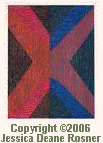Sketcher of various interrelated fourfolds.
Don’t miss the grove for the tree(s).
Methods of inquiry
December 13, 2010.
Latest significant change: September 17, 2013.Charles Sanders Peirce defined inquiry as any struggle to move from troublesome doubt to a secure belief, and outlined four methods, ordered from least to most successful.
| See "The Fixation of Belief" (1877): via peirce.org; via Arisbe; via Google |
- The method of tenacity (policy of sticking to initial belief) — which brings comforts and decisiveness but leads to trying to ignore contrary information and others' views as if truth were intrinsically private, not public. The method goes against the social impulse and easily falters since one may well notice when another's opinion seems as good as one's own initial opinion. Its successes can be brilliant but tend to be transitory.
- The method of authority — which overcomes disagreements but sometimes brutally. Its successes can be majestic and long-lived, but it cannot regulate people thoroughly enough to withstand doubts indefinitely, especially when people learn about other societies present and past.
- The method of the a priori — which promotes conformity less brutally but fosters opinions as something like tastes, arising in conversation and comparisons of perspectives in terms of "what is agreeable to reason." Thereby it depends on fashion in paradigms and goes in circles over time. It is more intellectual and respectable but, like the first two methods, sustains accidental and capricious beliefs, destining some minds to doubt it. (Corrected April 10 2013.)
- The method of science — the method wherein inquiry supposes a discoverable reality independent of particular opinion — the method, then, wherein inquiry, by its own account, can go wrong (fallibilism) as well as right (no radical skepticism) and thus purposely tests itself and criticizes, corrects, and improves itself. No destined doubts of the scientific method as such arise from its practice.
| Inquiry method: | Applying it to oneself, to others, consciously or unconsciously: |
| Method of authority, power, coercion. | Power-dependent or power-enhancing belief. Joining or submitting to the power in order to gain or keep power (what little of it one may have). Recruiting or coercing others. |
| Method of wealth, means, the "financial method." | Wealth-dependent or affluent belief. "Selling out" (in the bad sense). Paying or seeking to pay a wrongful price (of belief) in order to gain or keep means or wealth. Corrupting or extorting others. (One is reminded of the misprint "The Taxation of Belief" in the T.O.C. of the 1st edition of Chance, Love and Logic.) |
| Method of fashion, wattage, glamour or glory. | Fashionable belief. Manipulating oneself. Seeking to be manipulated, seduced. Manipulating and luring others. Rhetoric in the bad sense. Manipulative taunting and ridicule of opponents. |
| Method of status, standing. | Status-dependent or status-enhancing belief. E.g., status of the persuader as what is persuasive. (This is what is often meant by the appeal to authority, argumentum ad verecundiam, literally the argument to modesty or respect for another) Deceiving oneself. Cocksureness. Sophistry. Seeking to be deceived and to deceive others. Fraud. Fraudulant demotion of opponents to low status and obscurity. |
Thus the familiar force/fraud twofold becomes a fourfold, on the pattern of other fours.
| | Wrongs. | Causal terms of intelligent beings. | Realms of nature. | Tetrazed principles of the Four Causes. |
| 1. | Coercion, wrongful force (including that in theft, stealthy or otherwise). | Will. | Forces. | Agent. |
|---|---|---|---|---|
| 2. | Extortion, wrongful exploitation, corruption. (The non-deliberate version affecting a person, say, alone on an island, would consist in some imposition on that person's ability by the character of the resources there, especially such as to result in the person's doing something that s/he would otherwise refuse to do.) | Ability. | Matter. | Bearer. |
| 3. | Wrongful manipulation (wrongful luring, incitement, lulling, etc.). | Affectivity. | Life. | Act. |
| 4. | Fraud, wrongful deceit (including wrongful stealth, e.g., in theft). | Cognition. | Mind. | Borne. |
. . . . |



